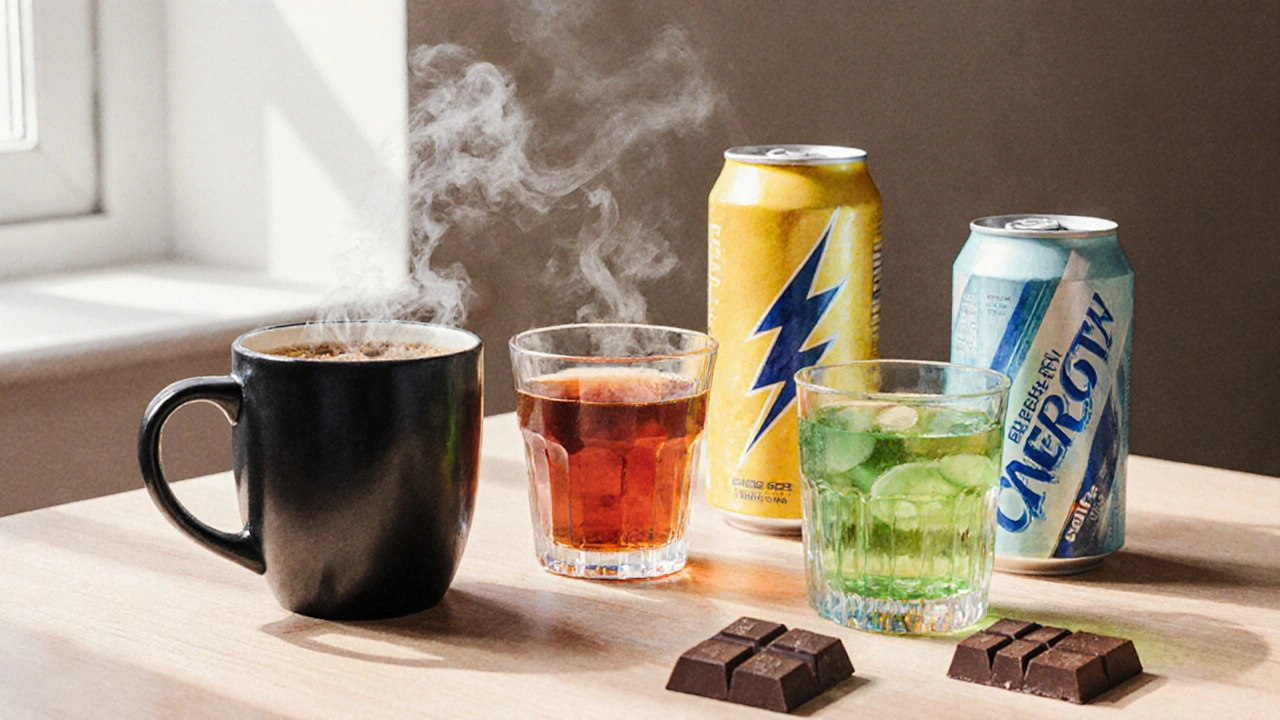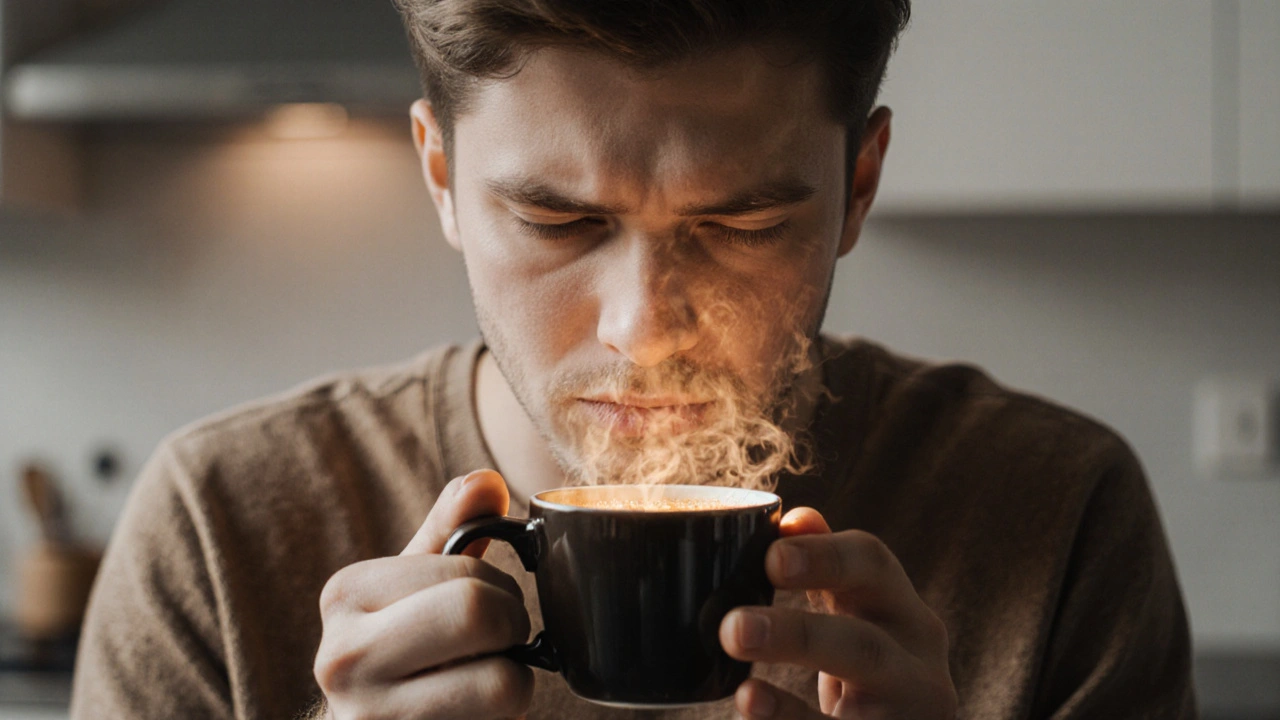Caffeine Trigger Calculator
Estimated Daily Caffeine:
0 mg
Based on article data
When it comes to stomach discomfort, Caffeine is a stimulant found in coffee, tea, chocolate and many soft drinks that can influence how your gut works. If you’ve ever noticed a flare‑up of bloating, nausea or burning after that morning espresso, you’re not alone - the link between caffeine and Functional Dyspepsia is a hot topic for gastroenterologists and patients alike.
What Is Functional Dyspepsia?
Functional dyspepsia (FD) is a chronic disorder of the upper digestive tract that causes pain or discomfort in the upper abdomen without an identifiable structural cause. Common symptoms include:
- Early satiety (feeling full quickly)
- Post‑meal fullness
- Burning or gnawing pain in the stomach
- Nausea or belching
According to the Rome IV criteria, the symptoms must be present for at least three months and cannot be explained by ulcers, reflux disease, or cancer. The condition affects up to 20% of adults worldwide and can severely impact quality of life.
How Caffeine Interacts with the Stomach
Two main pathways explain how caffeine may aggravate FD symptoms:
- Gastric Acid Secretion - Caffeine stimulates the parietal cells in the stomach lining, leading to increased hydrochloric acid production. More acid can irritate the stomach lining, especially in those with a hypersensitive gut.
- Gastrointestinal Motility - Caffeine speeds up the movement of the stomach and small intestine. For some, this rapid emptying can cause “dumping” sensations, while for others it may trigger spasms that feel like pain.
A 2022 meta‑analysis of 15 clinical trials found that participants who consumed >200mg of caffeine daily reported a 28% higher odds of worsening dyspeptic symptoms compared to low‑caffeine consumers.

Which Caffeinated Sources Matter Most?
Not all caffeine is created equal. The beverage or food matrix can modify how the stimulant affects your gut. Below is a quick look at the most common sources.
| Source | Caffeine per Serving | Typical Acid Level | Trigger Rating* |
|---|---|---|---|
| Coffee | 95mg (8oz) | High | High |
| Black Tea | 47mg (8oz) | Medium | Medium |
| Green Tea | 28mg (8oz) | Low | Low‑to‑Medium |
| Energy Drink | 80mg (250ml) | Variable (often high sugar) | High |
| Chocolate (dark, 70%) | 20mg per 30g | Low | Low |
*Trigger Rating reflects a combination of caffeine amount, acidity, and typical consumption patterns. “High” means most people with FD notice symptom worsening.
Practical Tips for Managing Caffeine‑Related Dyspepsia
Below is a checklist you can use the next time you’re planning your morning routine:
- Track your intake: Write down every caffeinated item for a week. Notice which ones line up with symptom spikes.
- Limit dose: Aim for <200mg of caffeine per day (about two standard coffees). If you’re sensitive, drop to under 100mg.
- Choose low‑acid options: Green tea or cold‑brew coffee tends to be gentler on the stomach.
- Avoid empty‑stomach caffeine: Eat a small, protein‑rich snack 15‑30 minutes before your drink to buffer acid.
- Mind the timing: Finish caffeine at least three hours before bedtime to reduce nighttime reflux symptoms.
- Consider decaf: Decaffeinated coffee still contains <1mg of caffeine per cup but has far less impact on acid secretion.
- Watch additives: Sugar, cream, and artificial sweeteners can also irritate the gut. Opt for plain or minimal additives.
When to Seek Professional Help
If you’ve cut back on caffeine and still experience persistent upper‑abdominal pain, it’s time to see a gastroenterologist. They might recommend:
- Proton Pump Inhibitor therapy to reduce acid production.
- Helicobacter pylori testing, as infection can mimic or worsen FD symptoms.
- Psychological interventions (e.g., cognitive‑behavioral therapy) because stress often amplifies functional gut disorders.
Early diagnosis helps prevent unnecessary investigations and lets you get back to enjoying meals without fear.
Bottom Line Checklist
- Identify how much caffeine you consume daily.
- Prefer low‑acid, lower‑caffeine drinks if you have FD.
- Never drink coffee on an empty stomach.
- Keep a symptom diary to spot patterns.
- Consult a doctor if symptoms persist despite dietary tweaks.
Frequently Asked Questions
Can I have a cup of coffee if I have functional dyspepsia?
It depends on your personal sensitivity. Many people can tolerate a small, low‑acid cup (e.g., cold‑brew) if they eat something first and keep total caffeine under 100mg per day. If symptoms flare, it’s safer to switch to tea or decaf.
Does decaf coffee still affect dyspepsia?
Decaf contains trace amounts of caffeine and still has some acidity, but the impact on stomach acid is minimal. Most FD patients find decaf to be a tolerable alternative.
Are there any non‑caffeinated drinks that can help soothe FD?
Herbal teas such as ginger, chamomile, or peppermint (in moderate amounts) can calm the stomach and reduce nausea. Warm water with a squeeze of lemon is another gentle option.
How long does it take for symptoms to improve after cutting caffeine?
Most people notice a reduction in bloating and pain within 3‑7 days of reducing caffeine, although full relief may take up to two weeks, especially if the gut has been chronically irritated.
Should I avoid all caffeine if I have FD?
Not necessarily. A moderate, well‑timed intake can be part of a balanced lifestyle. The key is to monitor your symptoms and adjust dosage accordingly.


Comments (10)
If you keep sipping that espresso without checking your stomach you’re basically neglecting your health :)
Life is a fragile tapestry woven with the bitter threads of caffeine and the soft sighs of a distressed stomach – oh the irony! Yet many blindly chase that dark elixir ignoring the silent rebellion inside. The moral compass points to moderation but society glorifies the jittery hustle. Perhaps the true rebellion lies in daring to sip tea instead of coffee? Think deeper and listen to your gut, for it whispers truths louder than any coffee buzz
Hey there! I totally get the love for coffee, but your gut will thank you if you swap a cup for green tea now and then. Small changes can make a big difference in how you feel throughout the day. Keep experimenting and listen to those signals! 🌟
For anyone dealing with functional dyspepsia, the first step is to log your caffeine sources and symptoms for at least a week. Then aim to keep total daily caffeine below 100 mg – that typically means one small coffee or a couple of teas. Pair this with low‑acid foods and avoid drinking on an empty stomach. If symptoms persist, consult a gastroenterologist for personalized guidance.
Ah, the classic “just log it and cut back” mantra – as if our lives are that simple! While your advice sounds neat, not everyone can just flip a switch on their beloved brew. Some of us cherish the ritual, the aroma, the cultural dance of the morning cup. Still, kudos for the tidy checklist.
Here’s a quick cheat‑sheet: ☕️ coffee ≤ 1 cup, ☕️ black tea ≤ 2 cups, 🍵 green tea ≤ 3 cups, 🍫 dark chocolate ≤ 30 g. Stick to these limits and watch your discomfort ease over a few weeks. 😊
Honestly this list is so basic it belongs in a high‑school health textbook lol. If you’re looking for real insight you need to read the primary studies – not some pop‑health blog. The nuance is lost when you dumb‑down it to “just cut back”.
The key takeaway is moderation and personal monitoring. Everyone’s tolerance varies, so tailoring intake to your own response is essential. Combining this with diet adjustments often yields the best outcome.
I feel your frustration; it’s like a storm raging in your belly every time you reach for that caffeine fix. Knowing you’re not alone can be a comforting lighthouse amidst the turmoil. Let’s navigate this together and find a gentler path.
Dear fellow reader, I appreciate your candid expression of distress. May I suggest a structured approach: first, maintain a detailed log of caffeine consumption alongside symptom severity; second, gradually replace high‑acid coffee with low‑acid alternatives such as green tea; third, schedule a follow‑up with your healthcare provider to assess progress. This systematic method often yields measurable improvement.